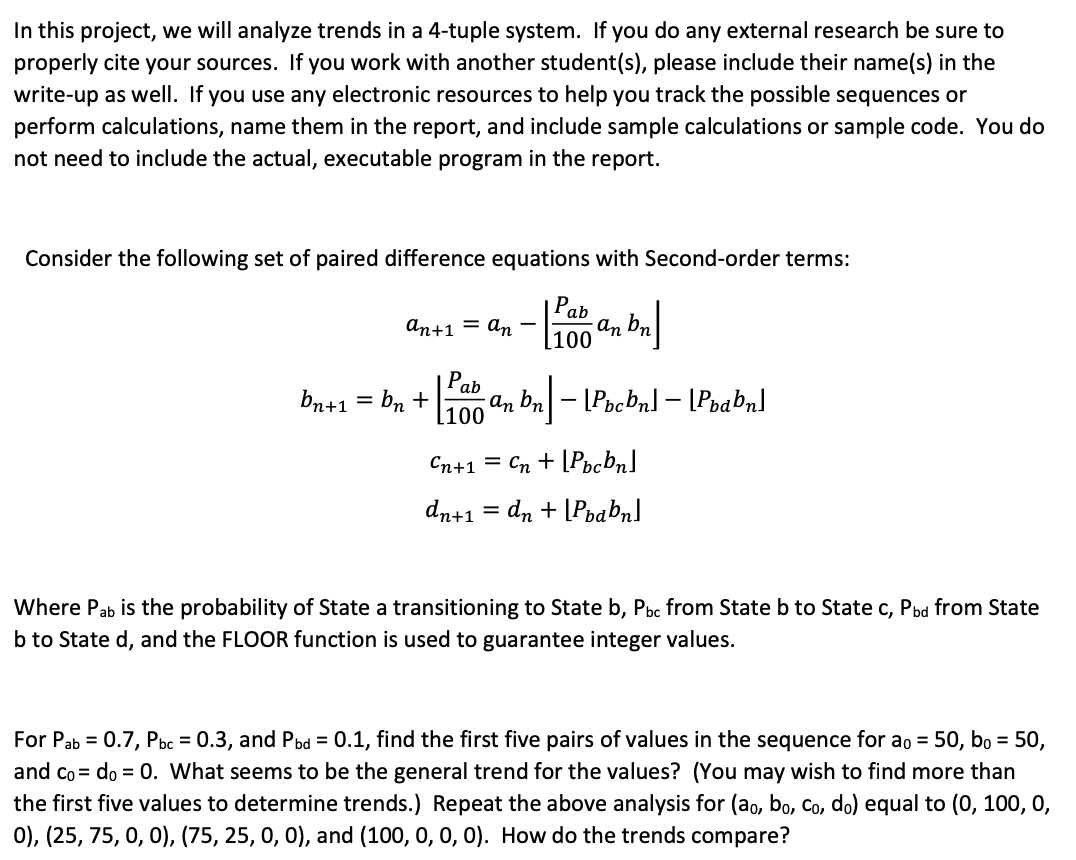Please explain as much as you can in your answer. Thanks!


Systems of n-tuple sequences are very often defined by their Steady State, where the inflow to one state is matched by its outgo, leading to a constant result. However, many systems include states with only inflow, and once entered are never left. These are called "absorbing states. (The converse, states with only outgo, which can never be returned to, are called "emitting states.) These states are often quite important, representing an algorithm that has completed its calculations and returned an answer. A single absorbing state might indicate the conclusion of a calculation and the return of a value. But there are more than one reason why an algorithm might halt. It could involve an intermediate value that makes further calculation impossible, like division by zero being undefined, or the assignment of a rational variable that is required to be an integer. In a physical system, there may be a physical fault that stops calculations, or maybe they require more resources than are available. And even if the algorithm is working perfectly, the Halting Problem is always an issue, so an algorithm may be shut down if it is seen as taking too long. So it is useful to look at a system with more than one endpoint. In this project, we will analyze trends in a 4-tuple system. If you do any external research be sure to properly cite your sources. If you work with another student(s), please include their name(s) in the write-up as well. If you use any electronic resources to help you track the possible sequences or perform calculations, name them in the report, and include sample calculations or sample code. You do not need to include the actual, executable program in the report. Consider the following set of paired difference equations with Second-order terms: Pab an+1 = an 100 - an bn Pab bn+1 = bn + Fan bnl - [Pbcbn] - [Pbabn] (100 Cn+1 = (n + [Pbcbn] dn+1 dn + [Pbabn] Where Pab is the probability of State a transitioning to State b, Pbc from State b to State c, Pbd from State b to State d, and the FLOOR function is used to guarantee integer values. For Pab = 0.7, Pbc = 0.3, and Pbd = 0.1, find the first five pairs of values in the sequence for ao = 50, bo = 50, and co= do = 0. What seems to be the general trend for the values? (You may wish to find more than the first five values to determine trends.) Repeat the above analysis for (ao, bo, Co, do) equal to (0, 100, 0, 0), (25, 75, 0, 0), (75, 25, 0, 0), and (100, 0, 0, 0). How do the trends compare? Systems of n-tuple sequences are very often defined by their Steady State, where the inflow to one state is matched by its outgo, leading to a constant result. However, many systems include states with only inflow, and once entered are never left. These are called "absorbing states. (The converse, states with only outgo, which can never be returned to, are called "emitting states.) These states are often quite important, representing an algorithm that has completed its calculations and returned an answer. A single absorbing state might indicate the conclusion of a calculation and the return of a value. But there are more than one reason why an algorithm might halt. It could involve an intermediate value that makes further calculation impossible, like division by zero being undefined, or the assignment of a rational variable that is required to be an integer. In a physical system, there may be a physical fault that stops calculations, or maybe they require more resources than are available. And even if the algorithm is working perfectly, the Halting Problem is always an issue, so an algorithm may be shut down if it is seen as taking too long. So it is useful to look at a system with more than one endpoint. In this project, we will analyze trends in a 4-tuple system. If you do any external research be sure to properly cite your sources. If you work with another student(s), please include their name(s) in the write-up as well. If you use any electronic resources to help you track the possible sequences or perform calculations, name them in the report, and include sample calculations or sample code. You do not need to include the actual, executable program in the report. Consider the following set of paired difference equations with Second-order terms: Pab an+1 = an 100 - an bn Pab bn+1 = bn + Fan bnl - [Pbcbn] - [Pbabn] (100 Cn+1 = (n + [Pbcbn] dn+1 dn + [Pbabn] Where Pab is the probability of State a transitioning to State b, Pbc from State b to State c, Pbd from State b to State d, and the FLOOR function is used to guarantee integer values. For Pab = 0.7, Pbc = 0.3, and Pbd = 0.1, find the first five pairs of values in the sequence for ao = 50, bo = 50, and co= do = 0. What seems to be the general trend for the values? (You may wish to find more than the first five values to determine trends.) Repeat the above analysis for (ao, bo, Co, do) equal to (0, 100, 0, 0), (25, 75, 0, 0), (75, 25, 0, 0), and (100, 0, 0, 0). How do the trends compare








